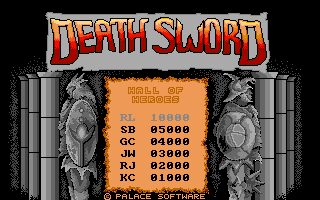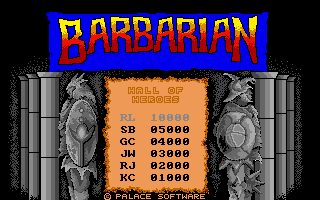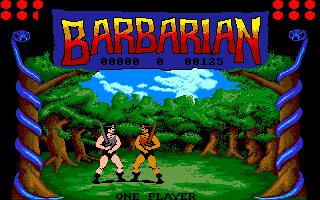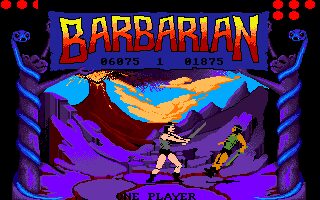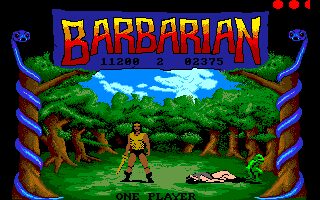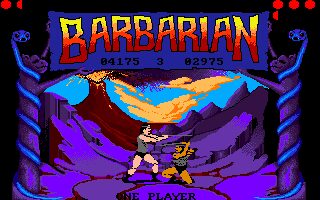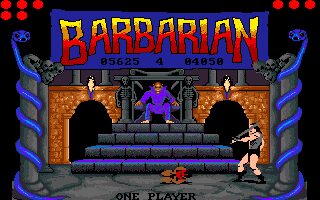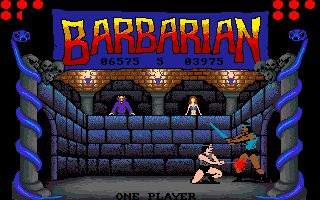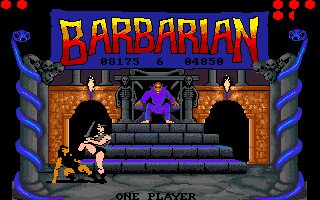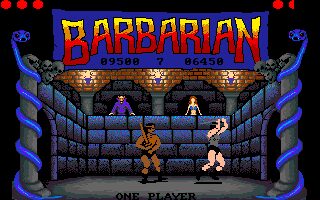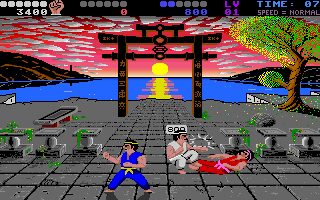Barbarian: The Ultimate Warrior (Death Sword in the United States) is a one or two-player fighting game developed by Palace Software.
The game, released in 1987 for the Commodore 64, was created by Steve Brown. It revolutionized fighting game visuals through its groundbreaking use of digitized graphics, capturing real human movements and translating them into pixel art with unprecedented realism for the era. It was subsequently ported to numerous platforms, including Amiga, Atari ST, Amstrad CPC, ZX Spectrum, DOS, and various other home computers.
The original Commodore 64 version established the template that would make Barbarian famous across multiple platforms. Palace Software employed a revolutionary technique of photographing real actors in various combat poses, then converting these images into detailed sprite animations. This process created character movements that possessed a weight and authenticity that hand-drawn sprites of the era simply couldn't match. The barbarian warriors moved with realistic muscle definition and natural motion that made contemporary fighting games look primitive by comparison.
The digitization process captured subtle details like the flex of muscles during sword swings, the realistic positioning of limbs during defensive stances, and the natural flow of hair and clothing during movement. Each frame of animation was painstakingly converted to work within the C64's hardware limitations, requiring clever use of the system's sprite capabilities and color palette. The result was a visual experience that felt almost photographic compared to the stylized character designs found in games like Kung-Fu: The Way of the Exploding Fist or International Karate +.
The Amiga version elevated Barbarian's visual presentation to new heights, taking full advantage of the platform's superior graphics capabilities. The additional colors and higher resolution allowed the digitized sprites to retain more detail and subtlety from the original photographs. Muscle definition appeared more pronounced, facial expressions became clearer, and the overall character animations gained a level of smoothness that made the C64 version seem crude by comparison. The Amiga's enhanced audio capabilities also improved the game's sound effects, with more realistic sword clashes and death screams that complemented the visceral visual presentation.
Combat mechanics center around one-on-one duels where players must master timing and distance to land devastating sword strikes while avoiding opponent attacks. The control system allows for various offensive moves including overhead chops, side slashes, and thrusting attacks, each requiring different timing and positioning to execute effectively. Defensive options include blocking and dodging, though the emphasis remains on aggressive swordplay rather than defensive maneuvering. The most infamous aspect involves the ability to decapitate opponents with perfectly timed strikes, followed by a small goblin character who drags away the headless corpse.
The game's structure follows a tournament format where players battle through increasingly difficult opponents to claim the title of ultimate warrior. Each enemy possesses different fighting patterns and difficulty levels, requiring players to adapt their strategies and learn new timing patterns. The final confrontation provides a genuine challenge that tests mastery of all combat techniques learned throughout the preceding battles.
Compared to other fighting games available during the same period, Barbarian stood apart through its realistic visual approach rather than relying on fantastical or stylized character designs. While Street Fighter and Fatal Fury would later establish the template for special moves and complex control schemes, Barbarian focused on realistic sword combat with an emphasis on timing and positioning over memorized combo sequences. The game shares similarities with Sword of Sodan in its medieval setting and weapon-based combat, though Barbarian's superior animation and more refined mechanics made it the more successful title.
The various platform versions each brought their own strengths and limitations to the Barbarian experience. The Atari ST version closely matched the Amiga's visual quality while offering slightly different color choices that some players preferred. The Amstrad CPC and ZX Spectrum versions made impressive attempts to recreate the digitized graphics within severe hardware constraints, though they inevitably suffered from reduced detail and animation frames. The DOS version provided solid performance on compatible systems but lacked the refined presentation of the 16-bit computer versions.
Barbarian's legacy lies in demonstrating that digitized graphics could create compelling gaming experiences when properly implemented. The technique would later be perfected by Midway in titles like Mortal Kombat, but Barbarian deserves recognition as one of the first games to successfully use photographic source material for character animation. Palace Software's innovation opened new possibilities for realistic character representation in video games, influencing countless developers who sought to capture authentic human movement in their digital creations.
The game's controversial marketing campaign, featuring a scantily clad model alongside the muscular barbarian character, generated significant media attention that helped establish the title's notoriety beyond gaming circles. However, the lasting impact comes from the technical achievement of creating believable human characters within the limitations of 1980s gaming hardware, proving that innovative visual techniques could overcome technological constraints to deliver memorable gaming experiences.

